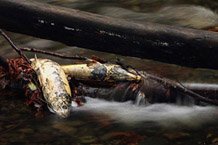Label Review Training: Module 4: Applying the Principles of Pesticide Label Review, Page 13
Section 4: How should I review for accuracy?
- Verify the accuracy of precautionary statements.
- Verify the accuracy of directions for use.
- Verify the accuracy of label claims.
Precautionary Statements
As discussed in Sections 1 and 2 in Module 3, certain precautionary statements depend on the results of toxicity studies performed on the technical grade of the active ingredient(s) in the product's formulation. The label reviewer must ensure that the statement language accurately corresponds to the study results.
For example, fish/aquatic invertebrate statements depend on the results of the fish acute

If field studies or accident history such as FIFRA 6(a)(2) reports indicate that the use of the pesticide may result in fatality to birds, fish, or mammals, the following statement has historically been required: “This pesticide is extremely toxic to [birds], [mammals], [fish], or [birds and mammals and fish].”
Resource
For more information about accurate precautionary statements, see Chapter 7, Chapter 8, and Chapter 9 of the Label Review Manual.
Page 13 of 24
Previous Page Next Page
